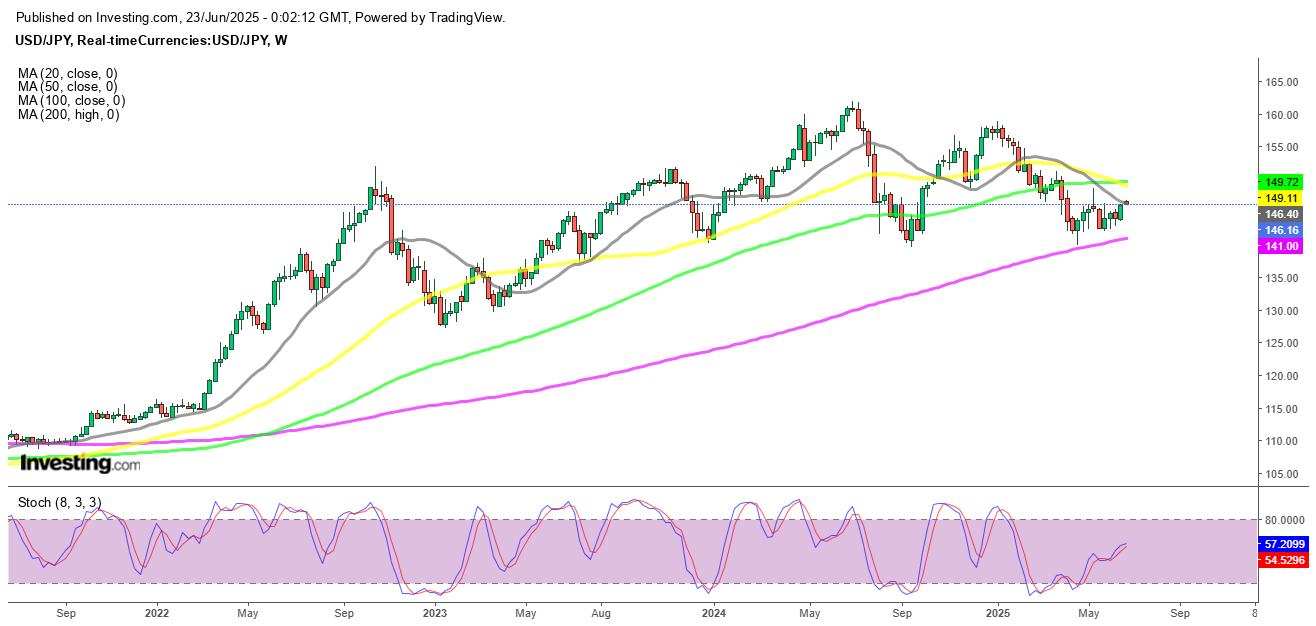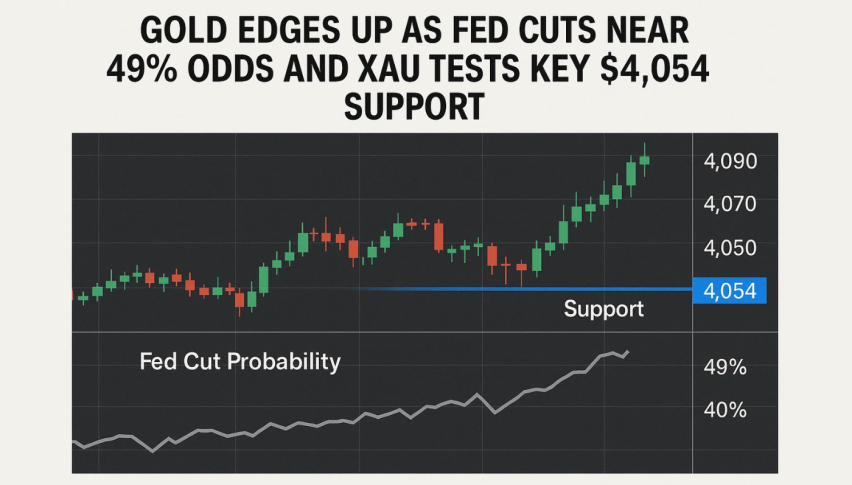Forex Signals Brief June 23: More Volatility Ahead for Gold, BTC, S&P 500 as Risks Multiply
A packed week of global economic events features key PCE inflation, sentiment surveys, and multiple central bank decisions that could shape.

Quick overview
- This week features significant global economic events, including key PCE inflation data and multiple central bank decisions that may influence market direction.
- Markets experienced volatility last week due to geopolitical tensions and commodity price fluctuations, with cautious trading observed as investors reacted to U.S. military actions in the Middle East.
- Gold prices declined despite heightened geopolitical risks, while the USD/JPY pair's movements were driven more by capital flows than fundamental factors.
- Bitcoin's price fell below the $100,000 support level, contrasting with Ethereum's strong performance driven by institutional demand and recent upgrades.
Live BTC/USD Chart
A packed week of global economic events features key PCE inflation, sentiment surveys, and multiple central bank decisions that could shape market direction ahead of July.
Last week saw markets caught in a volatile crosscurrent as geopolitical risk, commodity price swings, and central bank posturing shaped sentiment heading into the final stretch of June.
Cautious Trading Amid Escalation
Most financial markets experienced a choppy week as traders adjusted to the evolving conflict between Israel and Iran. A brief pullback in safe-haven demand was observed early in the week, notably in gold, which retreated during early U.S. trading hours. However, over the weekend, U.S. military strikes on Iranian facilities reignited investor concern. In response, crude oil opened nearly $3 higher, and the U.S. dollar gained broadly, even in the face of surprisingly dovish comments from Federal Reserve Governor Christopher Waller.
The broader consensus from the Fed — including Chair Jerome Powell — suggested little appetite for a rate move in July, dampening expectations of any imminent policy shift. Risk sentiment remained fragile as markets turned cautious.
This Week’s Forex Market Events:
This week features a global mix of inflation, sentiment, and growth indicators that could shift monetary policy expectations heading into July. The US Core PCE on Friday will likely be the most market-moving data point, but CPI prints from Australia, Canada, Japan, and the Eurozone will also guide policy outlooks globally. Central bank meetings in Hungary, Czechia, Mexico, and China round out a packed macro week, with investors eyeing confirmation or recalibration of easing timelines.
Upcoming Economic Data & Central Bank Events (Week Ahead Overview)
Monday
- Flash PMIs (June):
Key early snapshots of manufacturing & services sector activity from the Eurozone, UK, and US.
These figures often set the tone for global sentiment early in the week.
Tuesday
- Hungary NBH Rate Announcement:
Market watches for further easing steps amid high inflation volatility. - Germany Ifo Business Climate (June):
A major forward-looking indicator of sentiment from the largest EU economy. - Canada CPI (May):
Crucial for gauging how soon the BoC may begin cutting rates. - US Richmond Fed Manufacturing Index (June):
Regional snapshot of factory activity and supply-side trends.
Wednesday
- Bank of Japan Summary of Opinions:
Offers insights into internal policy debates as markets look for policy normalization clues. - Czech CNB Rate Decision:
Expected to hold rates, but tone will be scrutinized after previous dovish signals. - PBoC Medium-Term Lending Facility (MLF):
Watch for liquidity moves or signals on China’s easing path. - Australia CPI (May):
One of the RBA’s most-watched indicators ahead of its July policy meeting.
Thursday
- Banxico (Mexico) Policy Decision:
Markets expect a hold, but with potential dovish commentary amid inflation moderation. - Germany GfK Consumer Sentiment (July):
Key barometer of household confidence in Europe’s largest economy. - US Durable Goods Orders (May):
A leading indicator of industrial investment and business activity. - US Final Q1 GDP & PCE Prices:
Final read of Q1 growth and inflation – important ahead of Friday’s core PCE report.
Friday
- Japan Tokyo CPI (June):
The earliest inflation gauge in Japan; closely watched for BoJ policy shifts. - UK Q1 GDP (Final):
Expected to confirm recent modest growth rebound; key for BoE rate expectations. - France & Spain Prelim CPI (June):
First signs of Eurozone inflation trends ahead of the July ECB meeting. - Eurozone Economic Sentiment Survey (June):
Measures confidence across consumers, industry, and services. - US Core PCE (May):
The Fed’s preferred inflation metric – critical for rate cut timing in Q4.
Last week, markets were slower than what we’ve seen in recent months, with gold retreating as a result, the EUR/USD jumping above 1.16 but returned back below 1.15, while stock markets retreated on Friday. The moves weren’t too big though, and we opened 35 trading signals in total, finishing the week with 23 winning signals and 12 losing ones.
Gold Retreats Despite Geopolitical Stress
Despite the renewed Middle East risk premium, gold prices declined by almost 3% last week. The drop followed a dramatic surge in April 2025, when prices briefly touched a record $3,500 per ounce. The recent fall was primarily technical in nature, as gold failed to hold above short-term support levels.
Nonetheless, both the 20-day and 50-day simple moving averages once again acted as dependable support points. A cluster of doji candlesticks formed near the 20-day SMA on the daily chart — often a sign of investor hesitation before a potential directional move. Should tensions escalate further, gold may retest the $3,430–$3,450 range, with resistance still looming at the $3,500 all-time high. On the downside, a de-escalation scenario could pull prices toward $3,300 or lower.
USD/JPY Driven by Flows, Not Fundamentals
The USD/JPY pair showed behavior that diverged from the typical interest-rate spread narrative. Instead, capital outflows from Japan — driven by global yield-seeking and heightened geopolitical uncertainty — pushed the pair from 143.40 to 144.31.
Analysts view the movement as more flow-driven than fundamentally justified. Key resistance sits around 145.00, while immediate support lies at 142.70. Without a clear shift in risk sentiment, broader gains in the pair could lose steam.
USD/JPY – Weekly Chart
Cryptocurrency Update
Bitcoin Slides Below $100K Support
‘Bitcoin’s price action has turned more fragile in June, despite favorable developments like growing institutional interest and the landmark U.S. GENIUS Act, which has paved the way for more regulated stablecoin use. After reaching new record highs above $111,000 in May, Bitcoin sellers tested and eventually broke below the 50-day SMA, initially at $104,000.
The breach culminated in a fall below the key psychological $100,000 level on Sunday — the lowest since early May. Traders are now watching closely to see whether BTC finds solid footing at $100K, or dips further toward $90K, or even revisits April’s lows near $74,000. Despite the near-term uncertainty, long-term bullish sentiment remains intact for committed holders.
BTC/USD – Weekly chart
Ethereum Outperforms with Solid Fundamentals
In contrast to Bitcoin, Ethereum (ETH) has gained significant momentum. The world’s second-largest cryptocurrency has risen more than 20% since April, underpinned by institutional demand and the rollout of the Pectra upgrade, which enhanced staking mechanisms and wallet interface usability.
ETH is now contending with its 200-day moving average. A sustained break above this technical ceiling could pave the way for a push toward $4,000, potentially outpacing Bitcoin in performance over the coming weeks.
ETH/USD – Daily Chart
- Check out our free forex signals
- Follow the top economic events on FX Leaders economic calendar
- Trade better, discover more Forex Trading Strategies
- Open a FREE Trading Account



